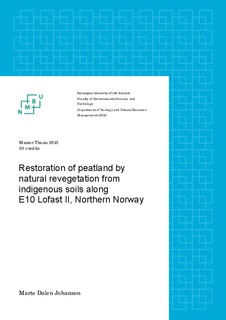Restoration of peatland by natural revegetation from indigenous soils along E10 Lofast II, Northern Norway
Master thesis
Permanent lenke
http://hdl.handle.net/11250/294070Utgivelsesdato
2015-07-31Metadata
Vis full innførselSamlinger
- Master's theses (INA) [593]
Sammendrag
Human degradation of peatlands causes large carbon emissions, loss of biodiversity and
reductions in ecosystem services. Ecological restoration is one of the practices trying to
mitigate the damages through assisting the recovery of degraded ecosystems. This study was conducted on restored peatland on roadsides along E10 Lofast II, Northern Norway. During roadside restoration, traditional methods of sowing seeds poses a risk of spreading alien species to adjacent areas. The sites in this study were revegetated using indigenous topsoil as the only restoration method. This is the first study of restoration success using this method in peatland ecosystems. Vegetation analysis was conducted in 108 plots of 1x1m in restored and undisturbed peatland, where the undisturbed peatland was used as the target vegetation type. Additionally, biotic and abiotic environmental factors were recorded for each plot. A Canonical Correspondence
Analysis (CCA) tested the effect of restoration on species composition.
The ordination showed differences in species composition between restored and undisturbed sites, indicating an incomplete restoration. Soil moisture, pH, slope and microtopography were recognized as the most important environmental drivers for species composition. Additionally, the ordination and linear regression showed that character peatland species decreased in abundance with increased depth of Polytrichum spp. cushion. The dominance of especially Eriophorum vaginatum, Polytrichum spp. and Carex rostrata in the restored peatland indicates that the site is still in an early successional stage. This is confirmed by previous studies that show a longer restoration time in peatland than in other ecosystems. The low soil moisture level is most likely limiting the establishment of Sphagnum spp. at the restored site. This might explain the poor establishment of other peatland species, as Sphagnum spp. is a key genus in forming the self-regulating peatland environment. Suggested improvements for future projects include shorter storage time of topsoil, storage in larger piles, redistributing of soil with respect to the natural microtopography of the area and rewetting
strategies.
